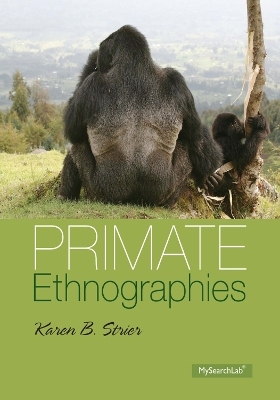
Primate Ethnographies
Routledge (Verlag)
978-0-205-21466-2 (ISBN)
Applies an ethnographic perspective to the study of primates
Primate Ethnographies, 1/e, is a collection of first-person accounts of immersive field studies of primates, people, and institutions, revealing the wide spectrum of primate science (primatology). Essays cover such primates as lemurs, New World monkeys, Old World monkeys, and apes. Readers experience the excitement of discovery and the challenges of primate field research. Primate Ethnographies can be used as a textbook or a companion reader.
MySearchLab is a part of the Strier program. Research and writing tools, including access to academic journals, help students explore ethnography in even greater depth. To provide students with flexibility, students can download the eText to a tablet using the free Pearson eText app.
NOTE: MySearchLab does not come automatically packaged with this text. To purchase the text with MySearchLab, order the package ISBN:
0205998631 / 9780205998630 Primate Ethnographies Plus MySearchLab with Pearson eText -- Access Card Package
Package consists of:
0205214665 / 9780205214662 Primate Ethnographies
0205239927 / 9780205239924 MySearchLab with Pearson eText -- Valuepack Access Card
Karen B. Strier is Vilas Professor and Irven DeVore Professor of Anthropology at the University of Wisconsin-Madison. After graduating from Swarthmore College in 1980, she received her MA and Ph.D. in Anthropology from Harvard University in 1981 and 1986, respectively. She is an international authority on the endangered northern muriqui monkey, which she has been studying in the Brazilian Atlantic forest since 1982. Her pioneering research has been critical to conservation efforts on behalf of this species, and has been influential in broadening comparative perspectives on primate behavioral and ecological diversity. Her contributions have been recognized by her election as a fellow of the American Association for the Advancement of Science, and as a member of both the National Academy of Sciences and the American Academy of Arts and Sciences. She is the recipient of an Honorary Degree (Doctorate of Science) from the University of Chicago and the Distinguished Primatologist Awards from both the American Primatological Society and the Midwestern Primate Interest Group. She has received various awards from the University of Wisconsin-Madison, including the Graduate School’s faculty research awards series, a Chancellor’s Distinguished Teaching Award, and a Hilldale Award for Excellence in Research, Teaching, and Service. She has also been honored with a Lifetime Honorary Membership to the Brazilian Primatological Society. Before joining the faculty at UW-Madison in 1989, she was a Lecturer in Anthropology at Harvard University and an assistant professor at Beloit College. She has served as an elected member and officer on the executive committees of professional societies and on the editorial boards of major journals in the field. She has authored or co-authored more than 100 publications, including two single-authored books, Faces in the Forest: The Endangered Muriqui Monkeys of Brazil (Harvard University Press) and Primate Behavioral Ecology, 4th edition (Pearson), a leading textbook in the field.
PART I: INTRODUCTION
1. Primate Ethnographies: The Biological and Cultural Dimensions of Field Primatology
By Karen B. Strier
PART II: STARTING OUT
2. There and Back Again: A Primatologist’s Tale
By Jim Moore
3. Moonlit Walks: A Serendipitous Journey from Baboons and Chimpanzees to Nocturnal Primates
By Leanne T. Nash
4. The Lure of Lemurs to an Anthropologist
By Robert W. Sussman
5. On the Ground Looking Up
By Kenneth Glander
6. Learning to Become a Monkey
By Michael A. Huffman
PART III: SOCIAL COMPLEXITIES
7. The Accidental Primatologist: My Encounters with Pygmy Marmosets and Cotton-top Tamarins
By Charles T. Snowdon
8. Of Monkeys, Moonlight, and Monogamy in the Argentinean Chaco
By Eduardo Fernandez-Duque
9. Stress in the Wilds
By Jacinta C. Beehner and Thore J. Bergman
10. Baboon Mechanics
By S. Peter Henzi and Louise Barrett
11. The Graceful Asian Ape
By Ulrich H. Reichard
PART IV: COMPARATIVE LENSES
12. Studying Lemurs on Three Continents
By Peter M. Kappeler
13. A Tale of Two Monkeys
By Stephen F. Ferrari
14. There’s a Monkey in my Kitchen (and I Like It): Fieldwork with Macaques in Bali and Beyond
By Agustín Fuentes
15. Gorillas Across Time and Space
By Martha M. Robbins
16. Chimpanzee Reunion
By Craig Stanford
PART V: CHANGES WITH TIME
17. Questions My Mother Asked Me: An Inside View of a Thirty-Year Primate Project in a Costa Rican National Park
By Linda Marie Fedigan
18. Male Bands in the Amazonian Rainforest
By Anthony Di Fiore
19. Blue Monkeys and Bridges: Transformations in Habituation, Habitat and People
By Marina Cords
20. The Evolution of a Conservation Biologist
By Colin A. Chapman
21. Studying Apes in a Human Landscape
By Jill D. Pruetz
APPENDIX: Tables of Cross-Referenced Regions, Species, and Key Topics and Concepts
| Erscheint lt. Verlag | 7.2.2014 |
|---|---|
| Verlagsort | New York |
| Sprache | englisch |
| Maße | 178 x 232 mm |
| Gewicht | 358 g |
| Themenwelt | Naturwissenschaften ► Biologie ► Evolution |
| Naturwissenschaften ► Biologie ► Ökologie / Naturschutz | |
| Naturwissenschaften ► Biologie ► Zoologie | |
| Sozialwissenschaften ► Soziologie | |
| ISBN-10 | 0-205-21466-5 / 0205214665 |
| ISBN-13 | 978-0-205-21466-2 / 9780205214662 |
| Zustand | Neuware |
| Haben Sie eine Frage zum Produkt? |
aus dem Bereich


